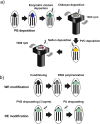New spin coated multilayer lactate biosensor for acidosis monitoring in continuous flow assisted with an electrochemical pH probe
- PMID: 39120744
- PMCID: PMC11315777
- DOI: 10.1007/s00604-024-06602-y
New spin coated multilayer lactate biosensor for acidosis monitoring in continuous flow assisted with an electrochemical pH probe
Abstract
A LOx-based electrochemical biosensor for high-level lactate determination was developed. For the construction of the biosensor, chitosan and Nafion layers were integrated by using a spin coating procedure, leading to less porous surfaces in comparison with those recorded after a drop casting procedure. The analytical performance of the resulting biosensor for lactate determination was evaluated in batch and flow regime, displaying satisfactory results in both modes ranging from 0.5 to 20 mM concentration range for assessing the lactic acidosis. Finally, the lactate levels in raw serum samples were estimated using the biosensor developed and verified with a blood gas analyzer. Based on these results, the biosensor developed is promising for its use in healthcare environment, after its proper miniaturization. A pH probe based on common polyaniline-based electrochemical sensor was also developed to assist the biosensor for the lactic acidosis monitoring, leading to excellent results in stock solutions ranging from 6.0 to 8.0 mM and raw plasma samples. The results were confirmed by using two different approaches, blood gas analyzer and pH-meter. Consequently, the lactic acidosis monitoring could be achieved in continuous flow regime using both (bio)sensors.
Keywords: Continuous monitoring; Diffusion limiting membrane; Healthcare assessment; Lactate amperometric biosensor; Spin coating procedure.
© 2024. The Author(s).
Conflict of interest statement
The authors declare no competing interests.
Figures






Similar articles
-
An improved amperometric L-lactate biosensor based on covalent immobilization of microbial lactate oxidase onto carboxylated multiwalled carbon nanotubes/copper nanoparticles/polyaniline modified pencil graphite electrode.Enzyme Microb Technol. 2017 Jan;96:177-186. doi: 10.1016/j.enzmictec.2016.10.014. Epub 2016 Oct 24. Enzyme Microb Technol. 2017. PMID: 27871380
-
Amperometric biosensor for direct blood lactate detection.Anal Chem. 2010 Jul 1;82(13):5568-72. doi: 10.1021/ac1004426. Anal Chem. 2010. PMID: 20518470
-
High-performance glucose biosensor based on chitosan-glucose oxidase immobilized polypyrrole/Nafion/functionalized multi-walled carbon nanotubes bio-nanohybrid film.J Colloid Interface Sci. 2016 Nov 15;482:39-47. doi: 10.1016/j.jcis.2016.07.067. Epub 2016 Jul 27. J Colloid Interface Sci. 2016. PMID: 27485503
-
Electrochemical lactate biosensor based upon chitosan/carbon nanotubes modified screen-printed graphite electrodes for the determination of lactate in embryonic cell cultures.Biosens Bioelectron. 2016 Mar 15;77:1168-74. doi: 10.1016/j.bios.2015.11.005. Epub 2015 Nov 4. Biosens Bioelectron. 2016. PMID: 26579934
-
A Comprehensive Review of Advanced Lactate Biosensor Materials, Methods, and Applications in Modern Healthcare.Sensors (Basel). 2025 Feb 10;25(4):1045. doi: 10.3390/s25041045. Sensors (Basel). 2025. PMID: 40006275 Free PMC article. Review.
References
Publication types
MeSH terms
Substances
Grants and funding
- ITI-0002-2019/Consejería de Salud y Familias, Junta de Andalucía
- ITI-0002-2019/Consejería de Salud y Familias, Junta de Andalucía
- ITI-0002-2019/Consejería de Salud y Familias, Junta de Andalucía
- ITI-0002-2019/Consejería de Salud y Familias, Junta de Andalucía
- PIN-0069-2019/Consejería de Salud y Familias, Junta de Andalucía
LinkOut - more resources
Full Text Sources
